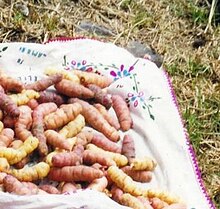User:KSRolph
KS Rolph is an American-born scholar. Rolph studied linguistics and physical anthropology, earning a B.A. in Anthropology, and a B.S. in Conservation and Natural Resources at the University of California at Berkeley (Class of 1995). Focused on linguistic anthropology and ecological linguistics, Rolph was a student of the prominent linguist and ethnobotanist Brent Berlin. Under Berlin, Rolph developed a critical analysis of Andean folk classification for Solanum tuberosum, or potatoes.
As a student of California Indian language revitalization scholar, Leanne Hinton, Rolph studied extinct California languages and sought to devise a color system for identifying grammatical elements. Under Hinton, Rolph began to look at indigenous place names and their significance. At Stanford University, Rolph earned an M.A. examining folk, medicinal, and genetic characteristics of common coca - Erythroxylum coca varieties. An M.S. focused on statistical trends, or changes to Homo dental morphology over 300,000 years (class of 2004). Rolph earned a doctorate in Stanford's Department of Anthropological Sciences researching ecological and linguistic anthropology in the Peruvian Andes (2007).[1]
In addition to studying physical anthropology and archaeology (including mummies and paleoindians), Rolph is knowledgeable about the Native American Graves Protection and Repatriation Act (NAGPRA). Working with living populations, especially the less privileged, Rolph sporadically reviews for the National Science Foundation and the National Institutes of Health. In support of human rights[2], she gave a talk at Stanford, describing widespread negative stereotyping of indigenous women in the Peruvian media.[3][4]
Rolph first began typological analyses of toponyms as a graduate research assistant under Joseph Greenberg. As his pupil, Rolph had access to the Greenberg Amerind Notebooks, word lists from native languages throughout the Western Hemisphere. Rolph is a specialist in toponyms (place names), language change, and ecological nomenclature, with a history of research within the moribund Ancash Quechua spoken in the north central Peruvian Andes.
From 2009 to 2013, Rolph was the peer-elected editor of the linguistics publication for the Society for the Study of the Indigenous Languages of the Americas [5] [6] and she speaks Spanish and German. Rolph has researched/studied the philology, etymology, and/or comparative structure of:

Indo-European:
- English
- German
- Spanish - Latin American - "Castellano"
- Portuguese - Brazilian - Eu estudei português brasileiro, mas não português de Portugal!
- French
Amerind:
- Quechua I and II - This is complicated. Ethnologue lists 30 living Quechuas in Peru alone!
- Tohono O’otham (Papago)
- Chumash - The language is extinct, but the Chumash people live on!
Dené–Yeniseian:
- Dene: Navajo Visit Navajo language Wikipedia!
- Sociolinguistics – Gender hierarchy, body language; time and landscape meanings
- Code switching – Youth speech, ethnic groups – informal language and communication
- Technolinguistics - UX and UxD, “apps” for native languages and youth adaptations, STEM education
- Ecological linguistics – Nomenclature used in farm production, nature, and rural landscapes
Rolph, who teaches anthropology, linguistics, ethnic studies, sociology,[7] and research methods with human populations, also teaches Wikipedia to college students in an effort to increase contributor-participation by females and ethnically diverse communities. Of particular interest are topics on culture, language, social structure, history, and cultural geography.KSRolph (talk) 03:54, 25 September 2011 (UTC)
References
- ^ http://books.google.com/books/about/Ecologically_meaningful_toponyms_Linking.html?id=AyB_-ZdryGkC
- ^ http://iis-db.stanford.edu/evnts/6822/Abstracts.pdf
- ^ http://iis-db.stanford.edu/pubs/23774/Rolph-Lazaro_012.pdf
- ^ http://blogs.ajws.org/blog/2011/07/19/peru-passes-law-against-racism-in-the-media/
- ^ SSILA
- ^ http://linguistlist.org/ssila/Bulletins/Archive/bull275.pdf
- ^ http://www3.uakron.edu/arm/resources/sociology/SYLLABUS%20QUALITATIVE%20METHODS%20IN%20SOCIAL%20SCIENCE%20RESEARCH,%20Stanford%20IB5.pdf
